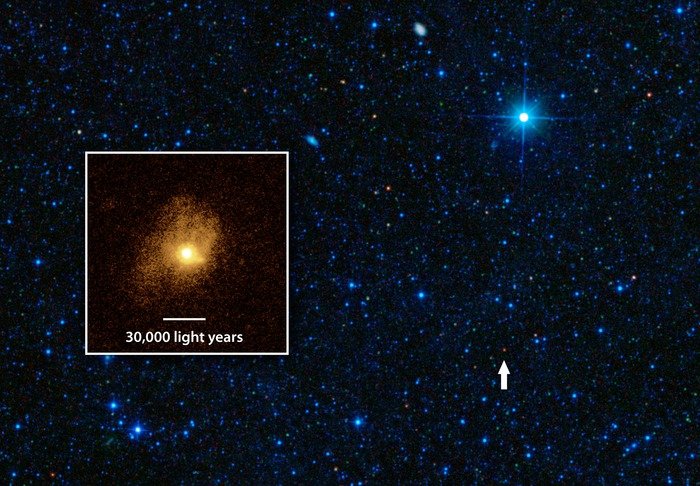The tiny red spot in this image (arrow) is one of the most efficient star-making galaxies ever observed, converting gas into stars at the maximum possible rate. The galaxy is shown here in an image from NASA's Wide-field Infrared Survey Explorer (WISE), which first spotted the rare galaxy in infrared light. Credit: NASA/JPL-Caltech/STScI/IRAM
PASADENA, Calif., April 23 (UPI) -- Astronomers say they've observed the most "energy efficient" galaxy ever seen, one that's converting fuel into stars with almost 100-percent efficiency.
Researchers used NASA's Wide-field Infrared Survey Explorer, the Hubble Space Telescope and the IRAM Plateau de Bure interferometer in the French Alps to observe the galaxy known as SDSSJ1506+54.
"This galaxy is remarkably efficient," lead study author Jim Geach of McGill University in Canada said. "It's converting its gas supply into new stars at the maximum rate thought possible."
Stars are formed out of collapsing clouds of gas in galaxies, but usually only a fraction of the total gas supply is actively forming stars, with the bulk of the fuel lying dormant, the astronomers said.
In the newly observed galaxy nearly all of the gas has been driven to its central core where it has ignited in a powerful burst of star formation, they said.
Astronomers say they're seeing the galaxy in a short-lived phase of evolution, possibly triggered by the merging of two galaxies into one. The rate of star formation is so prolific that in a few tens of millions of years -- in the blink of a cosmic eye --the gas will be used up
"We are seeing a rare phase of evolution that is the most extreme -- and most efficient -- yet observed," Geach said.
Hubble images show the galaxy is extremely compact, with most of its light emanating from a region just a few hundred light-years across, demonstrating a lot of star-making in a very little space, NASA's Jet Propulsion Laboratory in Pasadena, Calif., reported.
"While this galaxy is forming stars at a rate hundreds of times faster than our Milky Way galaxy, the sharp vision of Hubble revealed that the majority of the galaxy's starlight is being emitted by a region with a diameter just a few percent that of the Milky Way," Geach said.















